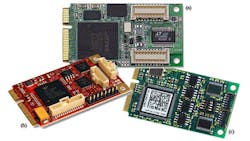PCI Express Mini Card Tackles Compact Embedded Expansion
There is a pretty large niche between the custom-designed embedded solution and stackable board-level expansion provided by PC/104-style solutions. This is a space where PCI Express Mini Cards, or Mini PCIe, fits rather nicely. They first found a home in laptops, providing wireless options.
The Mini PCIe includes x1 PCI Express (PCIe), USB 2.0, and SMBUS interface with an option for another PCIe lane. There are 1.5 V and 3.3 V versions. A variant called Mini-SATA (mSATA) replaces the PCIe interface with a SATA interface.
A variety of vendors provides a plethora of Mini PCIe options (Fig. 1). These provide a range of data acquisition options like Diamond Systems’ DS-MPE-DAQ0804 Analog I/O Module that has eight 16-bit analog input channels, four 16-bit analog output channels, and 21 configurable digital I/O lines. The analog inputs offer single-ended and true differential capability. An FPGA is used to manage the peripherals. Versalogic’s VL-MPEe-U2e Serial+GPIO has a dozen digital I/O lines and four serial ports. It even has a set of status LEDs. Accesio’s mPCIE-COM-4SM also has four-port RS-232/422/485 ports on its card.
This small collection of Mini PCIe cards just skims the surface. Wireless peripherals such as GPS, WiFi, Bluetooth, and ZigBee are available. Wired networking support is also available, such as 1 Gbit Ethernet ports or CAN.
An example of the mSATA variant is Innodisk’s mSATA Mini 3ME (Fig. 2). This provides MLC flash storage using a 6 Mbit/s SATA interface in a half-size form factor. Full-size cards have space for more flash chips. The mSATA form factor is being replaced by M.2 in most new ultrabooks and tablets. The M.2 form factor is slightly smaller and supports a modified SATA Express interface that includes PCI Express 3.0 and SATA 3.0. M.2 storage and network cards are available, but it has yet to make an impact in the embedded board space when it comes to data acquisition peripherals.
Mini PCIe expansion slots can be found on may single-board computers like PC/104-class motherboards. For example, Versalogic’s Atom-based Falcon EPU has a single Mini PCIe slot (see “PCI Express Mini Cards Provide Module Expansion” on electronicdesign.com). Diamond Systems’ Atlas PCI/104-Express also has a single Mini PCIe slot, but it also has a PCI and PCIe/104 OneBank connector. The Atlas PCI/104-Express runs an Intel, dual-core, Cedar Trail N2800 CPU and its Mini PCIe socket also support mSATA. The PCIe/104 OneBank works with Diamond Systems’ E104MPE expansion unit (Fig. 3) that supports four Mini PCIe devices. It supports full- and half-size cards and all sockets support PCIe and USB interfaces. SIM card support is provided for two of the sockets. PCIe and USB switches are used so only one lane for each is needed from the PCIe/104 socket.
If you just need more USB ports in addition to a Mini PCIe card, then check out Gateworks’ GW16112 (Fig. 4). It uses the USB 2.0 port and provides four additional USB ports. The Mini PCIe socket can be populated with a Mini PCIe card that does not use USB.
Mini PCIe cards have an advantage when it comes to size. They are also designed for rugged environments with mounting holes to keep the boards in place. One challenge will be the small connectors used with these boards, but are as rugged as their larger counterparts. The matching cables also tend to be smaller in diameter often simplifying cable routing.
About the Author
William G. Wong
Senior Content Director - Electronic Design and Microwaves & RF
I am Editor of Electronic Design focusing on embedded, software, and systems. As Senior Content Director, I also manage Microwaves & RF and I work with a great team of editors to provide engineers, programmers, developers and technical managers with interesting and useful articles and videos on a regular basis. Check out our free newsletters to see the latest content.
You can send press releases for new products for possible coverage on the website. I am also interested in receiving contributed articles for publishing on our website. Use our template and send to me along with a signed release form.
Check out my blog, AltEmbedded on Electronic Design, as well as his latest articles on this site that are listed below.
You can visit my social media via these links:
- AltEmbedded on Electronic Design
- Bill Wong on Facebook
- @AltEmbedded on Twitter
- Bill Wong on LinkedIn
I earned a Bachelor of Electrical Engineering at the Georgia Institute of Technology and a Masters in Computer Science from Rutgers University. I still do a bit of programming using everything from C and C++ to Rust and Ada/SPARK. I do a bit of PHP programming for Drupal websites. I have posted a few Drupal modules.
I still get a hand on software and electronic hardware. Some of this can be found on our Kit Close-Up video series. You can also see me on many of our TechXchange Talk videos. I am interested in a range of projects from robotics to artificial intelligence.

